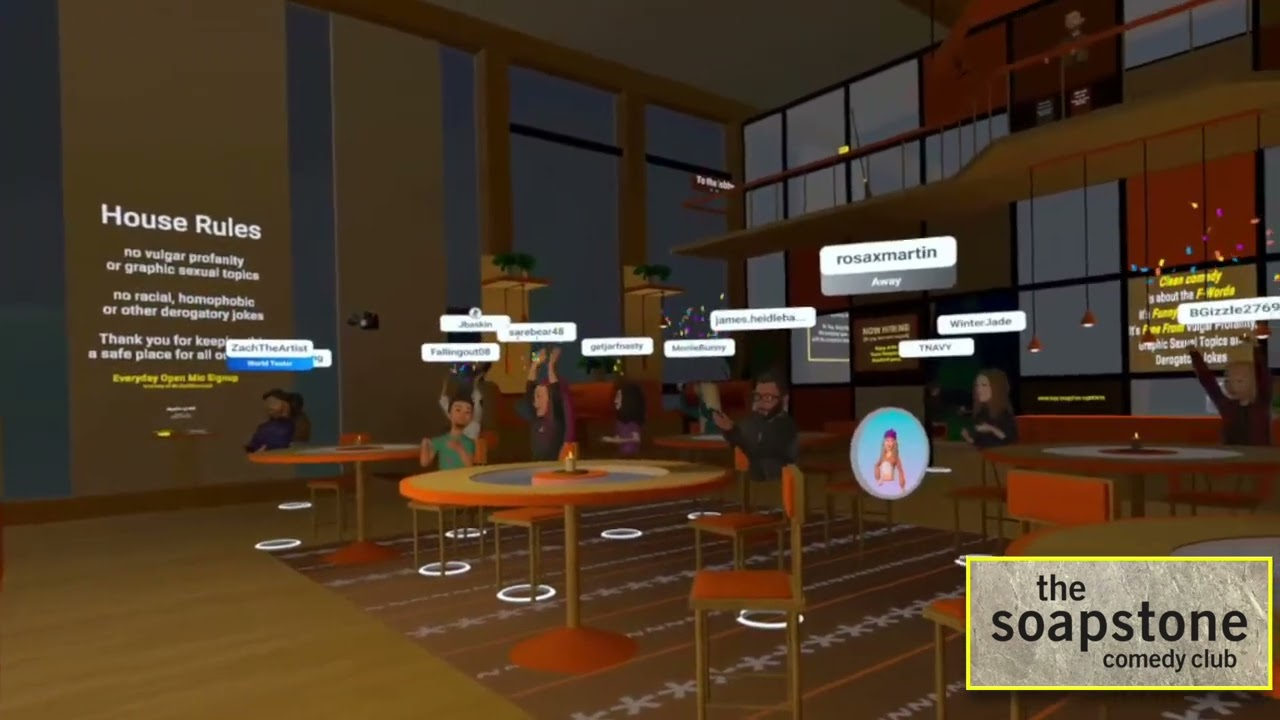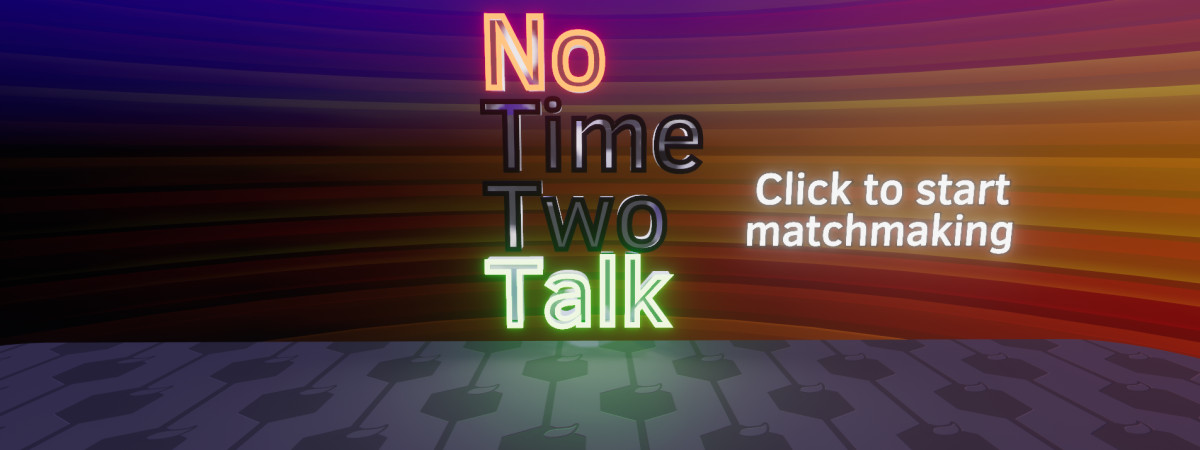Turning Strangers Into Friends In Virtual Reality: VR Social Architectures
This blog post is a call to action for the social VR platforms to get creative around helping strangers connect and become friends, what I call the social architecture.
With the rise of remote work and other changes in society, we've been in a multi-decade crises in third places that can help people to connect (this is one of the reasons I invented coworking, for example). Advances in social VR can help give healthy outlets for people to turn strangers into friends - I think that will be a positive thing for the world if done well.
“This blog post is a call to action for the social VR platforms to get creative around helping strangers connect and become friends, what I call the social architecture.”
 |
| Horizon's Soap Stone Comedy Club |
I've been personally experimenting with social VR the last few years, through Rec Room, VRChat, and Horizons. I was never into 3D shared worlds like Second Life before, but there is something intriguing about how embodied VR can be while connecting with other people that is different than a flat screen in my experience.
“Advances in social VR can help give healthy outlets for people to turn strangers into friends - I think that will be a positive thing for the world if done well.”
I've been playing a social VR game in Rec Room since 2017 called Laser Tag and have created community there; have been attending a VR comedy club in Horizons; and have been attending music & dance festivals in VRChat. I have a healthy physical social life, regularly meeting up with friends, going to real world meetups, doing very embodied activities like yoga, biking, and tap dancing, hosting real world neighborhood meetups, etc.
 |
| Rec Room's Laser Tag |
I don't see social VR as a replacement for physical activities but rather new territory opening up for social interaction, not unlike how a good book isn't a replacement for doing activities in the real world but rather even more new experiences to layer into a rich life. A life even wider with new and different possibilities, not a replacement. I'm not replacing my life with a VR headset, I'm expanding it into new territories I couldn't access before.
“I don't see social VR as a replacement for physical activities but rather new territory opening up for social interaction, not unlike how a good book isn't a replacement for doing activities in the real world but rather even more new experiences to layer into a rich life.”
However, a major issue with all these social VR platforms is that you are essentially interacting with lots of strangers, attempting to break the ice and find some common ground. This is layered on top with bad actors, named griefers, who just get in people's faces and want to create discord, usually young (mostly male) kids.
These are strong headwinds against social VR, and in the long run as VR becomes XR with lighter, more accessible, and cheaper headsets making XR mainstream, giant anonymous connection spaces might fade in preference to meeting up with friends & family in virtual and half-virtual settings (beaming your friend as a hologram onto your sofa via XR headsets to watch a movie together, for example, would be a half-virtual, or XR, setting).
“A major issue with all these social VR platforms is that you are essentially interacting with lots of strangers, attempting to break the ice and find some common ground.”
However, I do think broad social VR still has a place, especially as a location for earlier XR enthusiasts to connect before XR headsets have broader availability. One major problem is that the social VR platforms just aren't being creative in facilitating breaking the ice with lots of strangers -- they mostly are focusing on the more tangible 3D worlds, and not on the more subtle "social architecture" that can enable strangers to connect and have meaningful conversations.
“One major problem is that the social VR platforms just aren't being creative in facilitating breaking the ice with lots of strangers -- they mostly are focusing on the more tangible 3D worlds, and not on the more subtle "social architecture" that can enable strangers to connect and have meaningful conversations.”
Here are possible ideas for these social architectures to help break the ice between strangers. Think of it like an amazing party host in the real world — they know that two different people have common interests and introduce them together, mentioning their common interest, or a real world meetup you attend might have name tags where you can write a short interest you have related to the meetups subject to catalyze conversation.
Talking to strangers is hard, we need mechanisms to break the ice. I'm extroverted and quite good at talking to strangers in the real world, so some of these ideas are based on tricks I've used to engage conversations with strangers. Here's some ideas for better VR social architectures:
Automatch Interests
 |
| VRChat's No Time Two Talk |
Jerseys & Stickers
In the real world my laptop is covered with stickers on my interests, generally things related to space, computers, and machine learning. In coffee shops others have seen these and prompted conversation, or I'll see whats on their laptop and strike up talking about that.
T-shirts and hats can also play this function - "Oh did you go to such and such college (based on their hat)? Do you follow that sports team (if they are wearing a jersey)? Are you associated with that organization (some random t-shirt)?" etc. Basically, these give hooks to find some common ground to start a conversation. Social VR platforms should allow me to have t-shirts, caps, and stickers that I can add to my avatar that others can see to spur connection and conversation.
 |
| My personal laptop, with many nerd stickers to spur conversation |
Mood & "Whats On Your Mind?" Bubbles
Early web social platforms used to prompt people on their mood or brief thoughts, what if I could list my mood ("angry", "sad", "happy", "tired", etc.) or a short sentence ("Surviving finals", etc.) that might float above my avatar as a bubble. Again, this is another prompt and hook that someone can talk about - "Hey, why are you feeling sad?", "What happened today that you feel happy about?", etc.).
 |
| Example of early web social platforms "What's on your mind?" prompt |
Double Down on Real World Events Anchored by Real People in Social VR
Events help attract common "birds of a feather" together and create community. We should have real comedians present in social VR; we should have real book readings and discussions from authors; we should have scientists and interesting people giving real VR presentations, actually present as avatars, etc. Recorded events just aren't the same. Small, intimate events anchored by a real individual present as an avatar would do wonders. Imagine hosting Michael Nielsen talking about quantum computing or metascience, with a small intimate before and after conversation with all the people present being able to connect with him or others present. That will definitely raise the caliber of the kind of interactions people are having in social VR, not just a bunch of griefers streaming through causing havoc.
New Metrics
We need a new metric that tracks whether people are forming long running, meaningful connections on these platforms. This metric could track whether someone is making new friends, and whether they are continuing to connect with these people frequently and over the long term.
The healthiest VRChat interactions I've seen involve this — once you bust out of the public worlds into the private areas, you start to make friends and then connect with them more regularly.
“We need a new metric that tracks whether people are forming long running, meaningful connections on these platforms.”
Another metric might track whether you can get past the toxic griefers and public worlds into longer run, healthier social interactions. This is a very key metric for social VR platforms to get right, as ones first experience in social VR can be with these toxic griefers and it can turn you off of social VR completely, before you find the nicer, more private communities. This is another argument for very well curated events, like Altspace VR is attempting to do, to catalyze initial more intimate interactions to form a positive impression of social VR.
Conclusion
These are early days for XR in general. As headsets get lighter, have face tracking, get much more comfortable, etc. we will see much more broad adoption of this kind of socializing. However, social VR platforms really need to get their act together and be more creative on the interaction side -- a city is not just its buildings, but the subtle norms and ways that architecture helps people to connect, feel safe, or the opposite of that. Let's see a wave of creative experiments in the social architectures of VR platforms, not just endless sterile 3D buildings populated by griefers. I believe it's possible.
“Let's see a wave of creative experiments in the social architectures of VR platforms, not just endless sterile 3D buildings populated by griefers. I believe it's possible.”

Comments